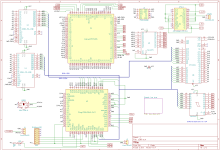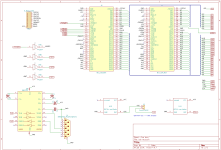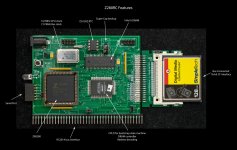Anyone want to comment on these schematics? Anything stand out as being horribly broken?
The plan is to have a Z280 in 16-bit ZBUS mode. An Altera CPLD acts as a 'chipset' to handle DRAM, PS/2 keyboard port, and signals for the 8-bit ISA slots. A 74373 latches/buffers some address lines. 74245 buffers some data lines. A MAX232 let's the UART connect to a DE-9 serial port. And there's an EPROM. 2x 1MB SIMMs would be installed, though bank switching would be needed to access the whole thing, since only 20 Z280 address lines have made it to the CPLD.
I'm thinking I'll be able to reprogram the CPLD in the board by using the jumper to tie the CPU's reset line low during the process. And if I run the CPU clock at something close to 14MHz then I can jumper that to go to the ISA OSC signal as well, rather than needing a separate crystal.
Originally I wanted to through everything and kitchen sink on there, but gradually tried to simplify it as much as possible while keeping the DRAM memory and ZBUS mode. I think I can route this on 2 layers but I'm not sure if it's even worth it to try. It seems that JLCPCB is offering cheap 4-layer boards now as well. I have not tried making a 4-layer board yet. Any thoughts?
The plan is to have a Z280 in 16-bit ZBUS mode. An Altera CPLD acts as a 'chipset' to handle DRAM, PS/2 keyboard port, and signals for the 8-bit ISA slots. A 74373 latches/buffers some address lines. 74245 buffers some data lines. A MAX232 let's the UART connect to a DE-9 serial port. And there's an EPROM. 2x 1MB SIMMs would be installed, though bank switching would be needed to access the whole thing, since only 20 Z280 address lines have made it to the CPLD.
I'm thinking I'll be able to reprogram the CPLD in the board by using the jumper to tie the CPU's reset line low during the process. And if I run the CPU clock at something close to 14MHz then I can jumper that to go to the ISA OSC signal as well, rather than needing a separate crystal.
Originally I wanted to through everything and kitchen sink on there, but gradually tried to simplify it as much as possible while keeping the DRAM memory and ZBUS mode. I think I can route this on 2 layers but I'm not sure if it's even worth it to try. It seems that JLCPCB is offering cheap 4-layer boards now as well. I have not tried making a 4-layer board yet. Any thoughts?




